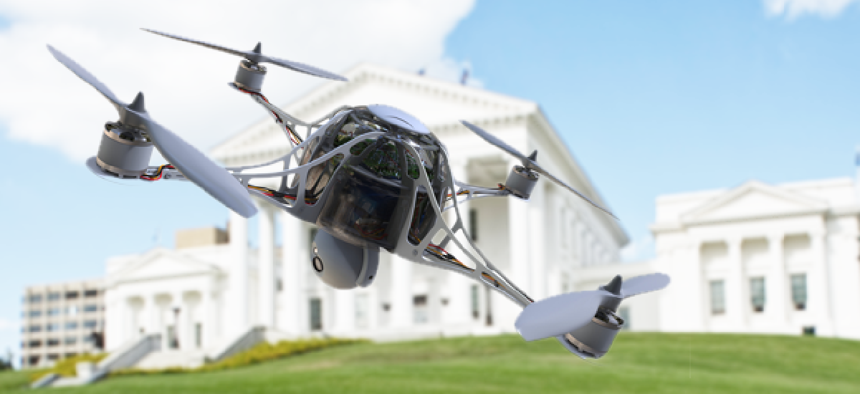Drones: Findable but not stoppable


Connecting state and local government leaders
Governments hoping to protect secure assets from unmanned aerial vehicles can find technology to help identify trespassing drones, but stopping them is another matter.
As the Federal Aviation Administration continues to lift restrictions on drones -- the latest change allows drones for recreational use that weigh under 55 pounds to fly up to 500 feet -- the skies will become more crowded with smaller aircraft that could pose problems for agencies that need to keep their buildings secure. Recently, the White House has had at least two public run-ins with drones flying near its restricted zone, and in Tokyo, a drone with radioactive material landed on the Japanese prime minister’s roof.
Despite warnings and prosecution, these instances will probably not be the last time drones buzz government facilities. Can state or local governments that do not have the Secret Service at their disposal protect key buildings that might be targeted by drone operators with malicious intent?
Some companies have developed drone detection solutions that measure the acoustic signature of the unmanned aerial vehicle’s propeller to identify its presence within a particular area as well as its model. DroneShield, a company based in Washington, D.C., provides an acoustic detection technology to help clients secure parameters from incoming, unwanted drones. Its sensor network and alerting service provides real-time warning and digital evidence collection, and can also detect and aircraft that might be invisible on radar systems.
DroneShield built a database with acoustic signatures of various drone models to prevent false alarms from ambient noise that might throw off the system. Company representatives said their omnidirectional sensors provide a range of 100-150 meters, though dishes can be outfitted to increase detection range, albeit with the omnidirectional trade-off. DroneShield systems are used by clients ranging from nuclear plants to the rich and famous, according to a CBS News report. When drones are detected, it’s up to the client to take the next step.
Similarly, Alsok’s detection service uses the drones’ sounds -- the spinning propellers -- as an audio fingerprint that identifies the make of drone. The Japanese company’s system uses audio sensors and can pick up sounds within 150 meters and compares them to a database of audio signatures. Additionally image sensors can capture the drone’s shape. After a drone is identified, the system sends alerts to security staff.
Drone Labs also utilizes radio frequency technology as part of its detection solution. The company’s Drone Detector can determine GPS coordinates of a drone, the altitude of a drone, the GPS coordinates of the operator and a unique identifier of a specific drone model – within a range of roughly 1,400 feet.
Drone Detector uses several layers of detection and expects to add video and thermal detection soon. While each method of presents limitations if used individually -- video detection has difficulty differentiating between birds and small UAVs, and most small drones do not emit enough heat to be picked up by thermal detectors -- together, the multifactor authentication works to identify both known and unknown types of drones.
And systems like these suggest that, if nothing else, the technology is quickly improving and coming down in price. Just last year at the Major League Baseball All-Star Game in Minneapolis, the Department of Homeland Security tested a drone detection program in what it called “Operation Foul Ball.” According to the New York Times, the system identified several small commercial drones, but had no way of stopping them from flying over fans. Additionally, the Times reported, the system “was considered one of the most advanced in the country, and cost several hundred thousand dollars to operate for just that night.”
That price tag puts the technology out of reach for just about everyone – even the feds.
NEXT STORY: State CIOs get nudge on drone policies




